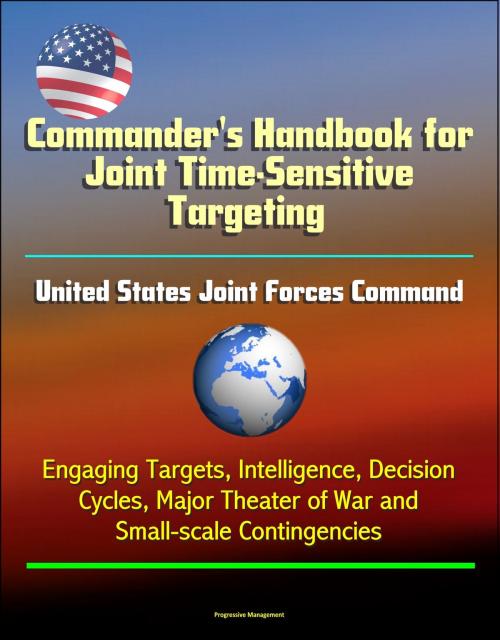Commander's Handbook for Joint Time-Sensitive Targeting: United States Joint Forces Command, Engaging Targets, Intelligence, Decision Cycles, Major Theater of War and Small-scale Contingencies
Nonfiction, History, Military, Strategy| Author: | Progressive Management | ISBN: | 9781311070456 |
| Publisher: | Progressive Management | Publication: | December 13, 2015 |
| Imprint: | Smashwords Edition | Language: | English |
| Author: | Progressive Management |
| ISBN: | 9781311070456 |
| Publisher: | Progressive Management |
| Publication: | December 13, 2015 |
| Imprint: | Smashwords Edition |
| Language: | English |
Professionally converted for accurate flowing-text e-book format reproduction, this Handbook is designed for joint force commanders and their staffs to assist them in rapid target engagement. It is meant to be a resource tool for the joint force commander, joint force headquarters, and the joint force components.
As we learned from experiences in such locales as Iraq, Kosovo, and Afghanistan, our ability to engage time-sensitive targets in a timely, efficient, and effective manner is a requisite for successful military operations. US forces are faced with an ever-increasing threat from adversaries that pose (or could pose) a direct danger and demand an immediate response. The complexities of engaging time-sensitive targets require joint force commanders and their staffs to fully appreciate the coordination and integration that are required to minimize the chance of fratricide and other collateral effects. This Handbook provides examples from combatant commands and joint task forces to assist in the prosecution of time-sensitive targets.
The United States Joint Forces Command Joint Warfighting Center and the Office of the Secretary of Defense Joint Warfighters Joint Test and Evaluation have developed this Commander's Handbook for Joint Time-Sensitive Targeting, to facilitate rapid target engagement by a joint force commander (JFC) within an operational area.
The focus of this handbook is on the processes required to engage joint TSTs in a timely, efficient, and effective manner. Only joint TSTs are addressed to highlight the coordination required between the joint force components to successfully engage these targets. Additionally, only targets on the Earth's surface, whether on land or sea, are discussed since joint doctrinal procedures are well established within the air and maritime components that effectively address engagement of time-sensitive air and subsurface targets, and therefore will not be discussed in this handbook.
This handbook has been developed expressly for:
JFCs—who develop and recommend rules of engagement, issue commander's guidance, establish risk parameters, and designate TSTs.
The joint force headquarters—those who prioritize targets, establish boundaries and control measures within an operational area, and coordinate and deconflict joint TST attack options among the joint force components.
The joint force component forces— those who ultimately employ the weaponry to engage joint TSTs.
Considerable emphasis has been given to the significance of the JFC guidance in the joint TST process. (Note: Throughout this handbook, maroon print has been used for additional emphasis or clarification.) As will be seen, not only is the JFC joint TST guidance an indispensable force-protection measure, it could be, depending upon the threat, one of the most critical decisions of the entire joint operation.
Professionally converted for accurate flowing-text e-book format reproduction, this Handbook is designed for joint force commanders and their staffs to assist them in rapid target engagement. It is meant to be a resource tool for the joint force commander, joint force headquarters, and the joint force components.
As we learned from experiences in such locales as Iraq, Kosovo, and Afghanistan, our ability to engage time-sensitive targets in a timely, efficient, and effective manner is a requisite for successful military operations. US forces are faced with an ever-increasing threat from adversaries that pose (or could pose) a direct danger and demand an immediate response. The complexities of engaging time-sensitive targets require joint force commanders and their staffs to fully appreciate the coordination and integration that are required to minimize the chance of fratricide and other collateral effects. This Handbook provides examples from combatant commands and joint task forces to assist in the prosecution of time-sensitive targets.
The United States Joint Forces Command Joint Warfighting Center and the Office of the Secretary of Defense Joint Warfighters Joint Test and Evaluation have developed this Commander's Handbook for Joint Time-Sensitive Targeting, to facilitate rapid target engagement by a joint force commander (JFC) within an operational area.
The focus of this handbook is on the processes required to engage joint TSTs in a timely, efficient, and effective manner. Only joint TSTs are addressed to highlight the coordination required between the joint force components to successfully engage these targets. Additionally, only targets on the Earth's surface, whether on land or sea, are discussed since joint doctrinal procedures are well established within the air and maritime components that effectively address engagement of time-sensitive air and subsurface targets, and therefore will not be discussed in this handbook.
This handbook has been developed expressly for:
JFCs—who develop and recommend rules of engagement, issue commander's guidance, establish risk parameters, and designate TSTs.
The joint force headquarters—those who prioritize targets, establish boundaries and control measures within an operational area, and coordinate and deconflict joint TST attack options among the joint force components.
The joint force component forces— those who ultimately employ the weaponry to engage joint TSTs.
Considerable emphasis has been given to the significance of the JFC guidance in the joint TST process. (Note: Throughout this handbook, maroon print has been used for additional emphasis or clarification.) As will be seen, not only is the JFC joint TST guidance an indispensable force-protection measure, it could be, depending upon the threat, one of the most critical decisions of the entire joint operation.















